Tiger Moths - Family Arctiidae
This page contains pictures and information about Tiger Moths that we found in the Brisbane area, Queensland, Australia.

Tiger Moths are small to medium in size. Many have bright warning colour patterns, which are spotted in red, orange, black or white. Their stout abdomen usually striped with black and yellow-red colour. The stripes give rise to the name "Tiger Moths". They are either distasteful or to predator or are mimic of distasteful species. Some even produce foul chemical.
Most Tiger
Moths fly at night but some are day-fliers.
Most Caterpillars of the ARCTIIDAE are covered in dense dark hairs, which gives them the name "Woolly Bears". The hairs can cause irritation in sensitive skin. The caterpillars are small to medium size. The caterpillars usually active during the daytime. If disturbed, they will roll into a tight spiral.
Most ARCTIIDAE caterpillars feed on herbaceous plants and easy to rear.
Subfamily ARCTIINAE
- Magpie Moth

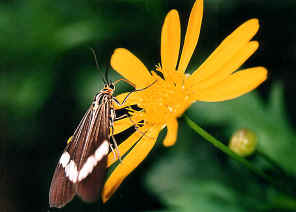
- Nyctemera secundiana, body length 25mm
- This Moths are sometimes seen in garden and roadside during daytime and also at night. Their forewings are dark brown with white patterned band across. Their abdomens have black and yellow rings. Their caterpillars are hairy with orange bands. More information please click here.
- Crimson Tiger Moth
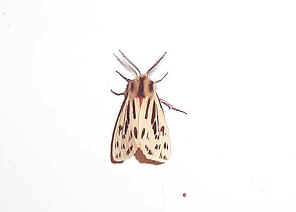
- Spilosoma curvata, Subfamily ARCTIINAE, body length 25mm
- This moth has a hairy body. The abdomen is red in colour with black marking. The thorax is pale brown in colour with a dark brown spot. The wing patterns are vary between individual. The caterpillar feed on young leaves of gum tree.
- Heliotrope Moth


- Utetheisa pulchelloides, body length 20mm
- This moth also known as Salt and Pepper Moth. We found this moth actively feeding on flowers during the day time on grass land. The moth was flying slowing among flowers. The moth is colourful, on its front wings there are red, brown and black dots on white background. We found this moth in late summer. More pictures and information can be found on this page.
Subfamily LITHOSIINAE
- Lichen Moth


- Asura lydia, body length 20mm
- Species in this subfamily LITHOSIINAE are commonly called Lichen Moth. The caterpillars have dense hair, may be found under log or on ground. They feed on litter or lichens. More pictures and information please visit this page.
- Lichen Moth Caterpillar on bark
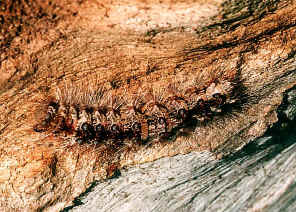
- Manulea replana, length 30mm
- Found on a decaying Gum tree trunk during the day. It active at night and feed on Lichens. The caterpillar is brown in colour with dense hairs. It pupates in a cocoon under sheltered crevice. The moth has wingspan 30mm, brown in colour with a yellow strip along forewings margin.
Subfamily CTENUCHINAE
- Orange Spotted Tiger Moth 1

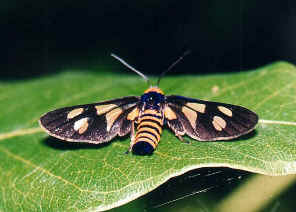
- Ceryx guttulosa, wingspan 30mm
- This moth is common in Brisbane bush. We can easily find them resting or flying openly in the Eucalyptus forest.
- Their wings are black with yellow-orange spots. It has black and yellow bands on its body. More pictures and information please click here.
- Orange Spotted Tiger Moth 2
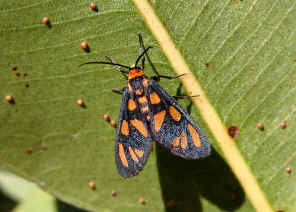
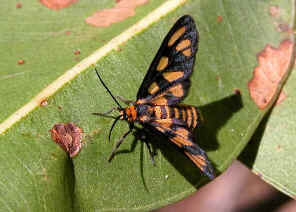
- Amata annulata, wingspan 30mm
- This moth is common in Brisbane bush. We sometimes find them resting or flying openly in the Eucalyptus forest. More pictures and information please visit this page.
- Triangular Tiger Moth

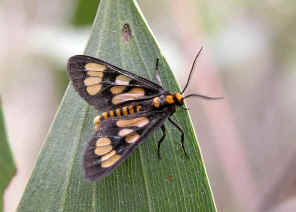
- ? Amata sp., body length 20mm
- We find this mating couple in Karawatha Forest in late summer. We can also find them near Stockyard Creek. This moth look similar to the Orange Spotted Tiger Moths (above) except it has the yellow patterns on its thorax. Then we found this moth is quite common in Brisbane bush. More information and pictures please visit this page.
